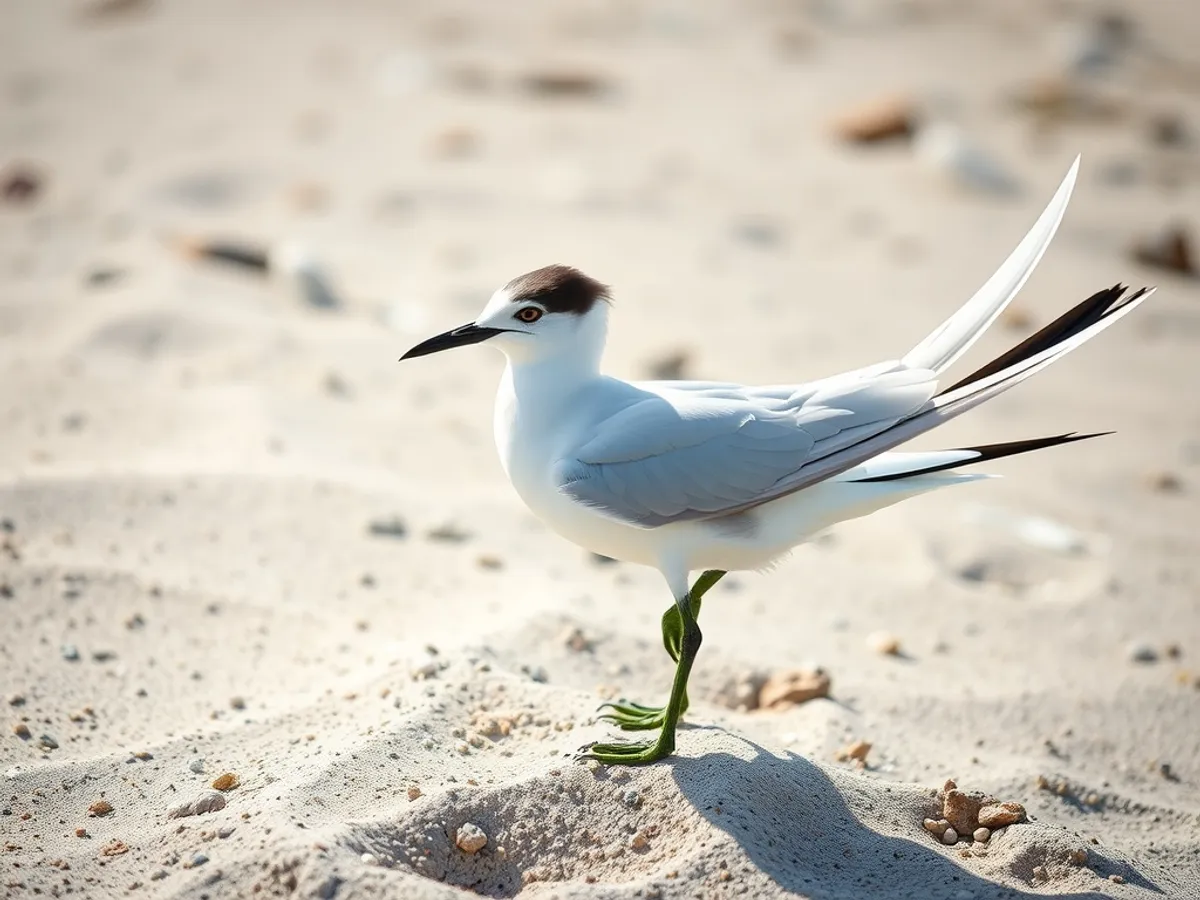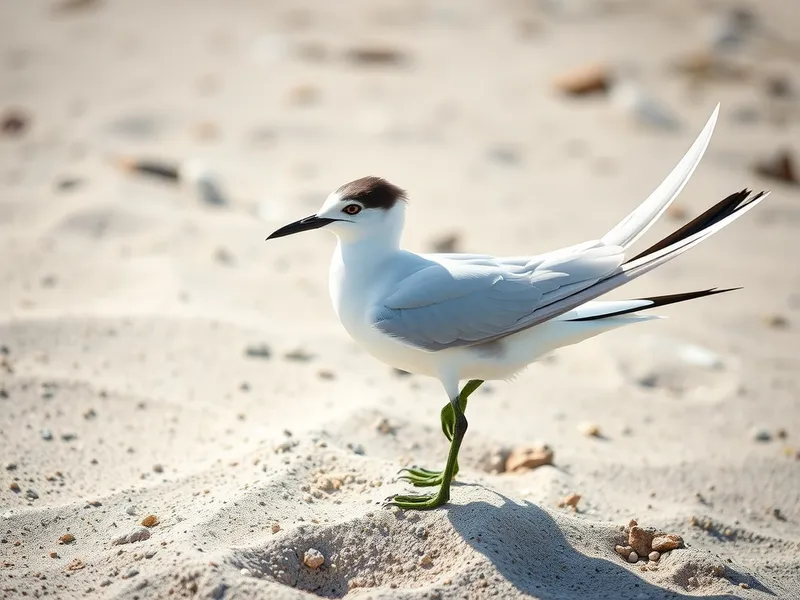
Elegant Tern
Thalasseus elegans

Meet the Elegant Tern
The Elegant Tern is a striking seabird known for its slender build, long, orange bill, and graceful flight. Adults display pale gray upperparts, white underparts, and a shaggy black crest during the breeding season, giving them a distinctive and 'elegant' appearance. Found primarily along Pacific coasts, they nest in dense colonies on sandy islands and forage over coastal waters for small fish. Their courtship displays include elaborate aerial acrobatics and distinctive calls. Elegant Terns are highly social, often forming large flocks outside the breeding season.
Classification
Bird
Habitat
Coastal beaches and offshore islands
Diet
Carnivore
Lifespan
15-20 years
Conservation
Near Threatened
Weight
200-400 grams
📖Fascinating Facts
Specialized Bill
The Elegant Tern's long, thin, orange bill is specifically adapted to snatch small fish just below the water's surface.
Colony Nesters
They nest in large, dense colonies, often sharing sites with other tern species and Heermann's Gulls.
Long-Distance Migrants
These terns migrate seasonally from breeding grounds in the Gulf of California to wintering areas as far south as Peru and Chile.
📋Detailed Description
The Elegant Tern (Thalasseus elegans) is a medium-sized seabird, measuring 40–43 cm (16–17 in) in length with a wingspan of 85–100 cm (33–39 in) and weighing approximately 200–250 grams. It is characterized by a slender, slightly decurved, bright orange bill, long pointed wings, and a deeply forked tail. During the breeding season, adults display a shaggy black crest extending from the forehead to the nape, contrasting with their white face, neck, and underparts, and pale gray upperparts. Outside the breeding season, the black crest recedes, leaving a mottled black and white crown. The legs are black and relatively short. Elegant Terns are highly gregarious, forming dense colonies on low-lying sandy islands and beaches, often in association with other tern species. Their flight is buoyant and graceful, with rapid wingbeats and frequent gliding. They are known for their distinctive, sharp, and far-carrying calls, especially during social interactions and courtship. The species is migratory, breeding along the Pacific coasts of southern California and western Mexico, and wintering as far south as Peru and Chile. Their plumage and morphology are adapted for a life spent mostly at sea, only coming ashore to breed and rest.
💡 Did you know?
Over 90% of the world's Elegant Terns breed on a single island, Isla Rasa in the Gulf of California, making the species vulnerable to localized threats.
🔬Research & Sources
Wikipedia Summary
The elegant tern is a tern in the family Laridae. It breeds on the Pacific coast of southern California in the United States and western Mexico, and migrates south to Peru, Ecuador and Chile for the northern winter; in the late summer and fall, some also disperse north to Oregon and more rarely Washington.
Last Modified: 5/14/2025
🎭Behavior & Social Structure
Elegant Terns are diurnal and spend most of their day foraging over coastal waters, often in flocks. They employ plunge-diving as their primary hunting technique, hovering briefly before diving headfirst into the water to catch small fish, particularly anchovies (Engraulidae) and sardines (Clupeidae). Feeding is often cooperative, with flocks tracking schools of fish and responding to the movements of marine predators such as dolphins or predatory fish that drive prey to the surface. Social interactions are complex, involving vocalizations and aerial displays, especially during the breeding season. Outside of breeding, they roost communally on sandbars or beaches. Elegant Terns are known for their strong site fidelity, returning to the same breeding colonies year after year. They exhibit a strict daily routine, alternating between foraging trips and periods of rest or preening.
👶Reproduction & Life Cycle
Breeding occurs from April to July, primarily on isolated sandy islands with minimal vegetation. Courtship involves aerial displays and ritualized fish offerings by males to females. Nests are simple scrapes in the sand, often closely spaced within dense colonies. The typical clutch consists of one, occasionally two, pale buff eggs with dark blotches. Both parents share incubation duties, which last about 22–24 days. Chicks are semi-precocial, hatching with down and capable of limited movement. After hatching, chicks form crèches (nursery groups) while parents forage, returning to feed their own offspring by recognizing their calls. Fledging occurs at about 28–35 days, but parental care may continue for several weeks post-fledging. Breeding success is highly dependent on food availability and colony disturbance.
🛡️Adaptations & Survival
Elegant Terns possess several adaptations for a marine lifestyle. Their long, pointed wings and lightweight bodies enable efficient long-distance flight and agile maneuvering over water. The slender, decurved bill is specialized for grasping slippery fish. Their plumage is highly water-resistant, aiding in buoyancy and insulation. The species' social nesting behavior provides protection against predators through collective vigilance. Their vocal communication is well-developed, facilitating mate recognition and chick-parent bonding in dense colonies. Physiologically, they are capable of excreting excess salt via specialized nasal glands, allowing them to consume seawater.
🎨Cultural Significance
Elegant Terns are not widely featured in folklore or mythology, but they are valued by birdwatchers and ecotourism operators, especially in California and Mexico. Their striking appearance and dramatic courtship displays make them a favorite among coastal birding communities. In some regions, they serve as indicators of marine ecosystem health due to their reliance on small pelagic fish populations.
🔬Recent Research & Discoveries
Recent research has focused on the effects of climate variability (such as El Niño events) on breeding success and foraging ecology, revealing that Elegant Terns are highly sensitive to changes in prey abundance. Genetic studies have clarified their relationships within the Thalasseus genus, confirming their distinction from closely related species like the Royal Tern (Thalasseus maximus). Ongoing monitoring at major colonies, such as Isla Rasa in the Gulf of California, provides valuable data on population dynamics, migration patterns (including satellite tracking), and responses to conservation interventions. There is active research on the impacts of marine pollution and fisheries management on tern foraging success.
🎥Wildlife Videos
![[Elegant Tern] Elegant Tern Amazing Facts || Where To Find Elegant Tern](https://i.ytimg.com/vi/6HbP8BS7sbE/hq720.jpg?sqp=-oaymwE2COgCEMoBSFXyq4qpAygIARUAAIhCGAFwAcABBvABAfgB_gmAAtAFigIMCAAQARhaIFooWjAP&rs=AOn4CLB6NfTd4G30CnuF5dyvZ3RtFzMgKQ)
[Elegant Tern] Elegant Tern Amazing Facts || Where To Find Elegant Tern
[Elegant Tern] Elegant Tern Amazing Facts || Where To Find Elegant Tern Our social links. Facebook: ...
The Zoological World

ELEGANT TERN
A SEA BIRD THAT HOVERS AND DIVES FOR ITS FOOD IN THE OCEAN, BAYS AND ESTUARIES.
naturebytesvideo

Elegant terns courting
Elegant terns (Thalasseus elegans) courting, Southern California, USA, March. © John Chan/naturepl.com ...
Nature Picture Library

River Tern Preening - A Moment of Elegance | Wildlife Documentary | Migratory Bird | Nature | River
The sight of a River Tern preening by the water's edge is a quiet yet captivating display of nature's elegance and the meticulous ...
Divine Wildlife

Elegant Terns - StoneWater Wildlife
Elegant Terns.
StoneWater Wildlife

North American Wildlife --- Elegant Tern colony, along with a few Caspian Terns
American Wildlife
🌍Habitat Information
The Elegant Tern typically inhabits Coastal beaches and offshore islands environments. Elegant Terns have adapted to their environments with specialized features and behaviors.
Primary Habitat:
Coastal beaches and offshore islands
More detailed habitat information will be available soon.
🛡️Conservation Status
The Elegant Tern is currently classified as Near Threatened. Conservation efforts are crucial for preserving this species for future generations.
Common Threats:
- 🏠Habitat loss and fragmentation
- 🌡️Climate change impacts
- 🎯Hunting and poaching
- 🏭Human-wildlife conflict
⚠️Threats & Conservation Challenges
The main threats to Elegant Terns include habitat loss due to coastal development, human disturbance at breeding colonies, predation by introduced mammals (such as rats and cats), and climate change impacts such as sea-level rise and increased storm frequency. Overfishing of their primary prey species (anchovies and sardines) can lead to food shortages, reducing breeding success. Oil spills and marine pollution pose additional risks. Although the global population is estimated at 50,000–100,000 individuals, recent trends show declines at some key colonies, prompting the IUCN to list the species as Near Threatened. Conservation efforts focus on protecting breeding sites, managing human access, and monitoring population trends.
🔬Scientific Classification
Scientific Name
Thalasseus elegans
Classification Hierarchy
🔍 About Taxonomic Classification
Taxonomic classification is a hierarchical system used by scientists to classify and organize living organisms based on shared characteristics and evolutionary relationships.
The system moves from broad categories (Kingdom) to increasingly specific ones, with each animal's scientific name typically consisting of its Genus and species.
📝Community Notes
Share your observations and insights about the Elegant Tern with our community of wildlife enthusiasts.
Join Our Community
Sign in to share your observations and connect with fellow wildlife enthusiasts.
Sign In to ContributeNo community notes yet
Be the first to share your observations about the Elegant Tern!
Explore Elegant Tern
Select a tab above to learn more about this amazing animal.
📸Photo Gallery
No photos available for this animal yet.
🌟Discover More Wildlife
Continue your journey of discovery with more fascinating animals from our database
